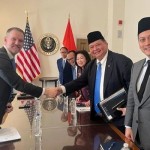Total number of posts 460.
Amid deepening economic integration, Vietnam aims to help its enterprises—particularly SMEs—expand internationally. The Ministry of Industry and Trade is currently developing the “Go Global” Program to support Vietnamese businesses in reaching global markets. One key pathway for SMEs to “go global” is through leveraging the benefits of free trade agreements (FTAs), with the RCEP standing out as a major framework. As the world’s largest free trade agreement, RCEP connects 15 economies, enabling Vietnamese SMEs to benefit from tariff reductions, simplified customs procedures, and diversified supply chains, thereby enhancing competitiveness, reducing costs, and expanding exports across the region.
As Vietnam’s integration into regional and global markets accelerates and domestic enterprises grow stronger, expanding to regional markets has become an increasingly realistic goal, one that has gained government attention. The Ministry of Industry and Trade (MOIT) is formulating the “Go Global” Program to promote international expansion for Vietnamese enterprises, including SMEs, with FTAs serving as a key enabler.
The Regional Comprehensive Economic Partnership (RCEP), the world’s largest trade agreement, led by ASEAN, has created new opportunities for Vietnam’s SMEs to grow and compete regionally. By removing trade barriers across Asia, RCEP offers Vietnamese businesses lower tariffs, faster customs clearance, and more diversified supply chains.
Vietnam among the biggest beneficiaries of RCEP
When RCEP took effect in 2022, the World Bank projected that Vietnam would gain the most economically among RCEP members. This forecast is materializing: by 2025, Vietnam’s GDP is expected to grow 6.6% (with the government targeting up to 8%), the highest in ASEAN. RCEP links 15 economies, the 10 ASEAN members plus Australia, China, Japan, South Korea, and New Zealand, representing about 30% of global GDP and trade. By the end of 2024, trade between Vietnam and RCEP members accounted for over half of Vietnam’s total trade, reflecting its deeper integration into regional value chains.
Beyond these numbers, RCEP offers Vietnamese SMEs tangible, long-term advantages:
(i) Tariff reductions enhance competitiveness
High import and export taxes have long been a challenge for small firms. RCEP addresses this by eliminating or reducing tariffs on at least 92% of traded goods, either immediately or within 20 years. Lower trade costs allow Vietnamese exporters, such as textile manufacturers, to price more competitively in foreign markets. According to the World Bank, Vietnam is projected to lead all RCEP members in export growth between 2020–2035 at 11.4%, solidifying its position as a regional export hub.
(ii) Simplified customs procedures reduce delays
Cumbersome customs procedures often slow cross-border trade. RCEP improves efficiency by promoting digital customs processing and pre-arrival clearance. Member countries are required to clear express and perishable goods within six hours and process most shipments within 48 hours of arrival. These reforms help Vietnamese SMEs reduce logistics costs, speed up deliveries, and build trust with international customers.
(iii) Diversified supply chains mitigate risk
RCEP’s broad membership includes key suppliers of Vietnam’s production inputs, China, South Korea, and Japan. With unified rules of origin, SMEs can import materials from any RCEP country and still enjoy preferential tariffs when exporting. This enhances supply chain flexibility, lowers costs, and strengthens resilience amid global disruptions.
(iv) Turning policy into real growth
Maximizing RCEP’s potential depends on efficient logistics and international shipping capacity. Recognizing this, FedEx expanded its operations in Vietnam in 2025, adopting a direct-serve model that provides faster international delivery, digitalized tools, and enhanced customs support. This helps SMEs streamline exports, access global customers faster, and operate more cost-effectively.
Vietnam in the RCEP Era
Vietnam’s participation in multiple FTAs demonstrates its strong commitment to global integration. Yet, RCEP stands out for its vast scale and its transformative potential for Vietnam’s SMEs within regional value chains. By leveraging tariff preferences, improving logistics capabilities, and embracing digital transformation, Vietnamese SMEs can evolve from local players into regional exporters.
RCEP thus serves not only as a trade facilitation framework, but also as a strategic platform that empowers Vietnam’s SMEs to strengthen competitiveness, expand markets, and achieve sustainable growth in the new era of globalization.
Source: FedEx














